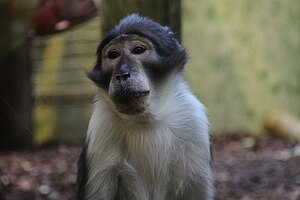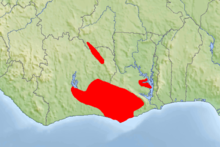White neck indication
| White neck indication | ||||||||||||
|---|---|---|---|---|---|---|---|---|---|---|---|---|

White nape specimen ( Cercocebus lunulatus ) |
||||||||||||
| Systematics | ||||||||||||
|
||||||||||||
| Scientific name | ||||||||||||
| Cercocebus lunulatus | ||||||||||||
| Temminck , 1853 |
The white- naped specimen ( Cercocebus lunulatus ), also known as the white-crowned specimen , is a species of primate from the family of vervet monkeys (Cercopithecidae). It occurs in the center and east of the Ivory Coast , in the southwest of Burkina Faso and Ghana between Sassandra and Volta . The white neck indication was previously classified as a subspecies of the soot indication ( Cercocebus atys ) or the collar indication ( Cercocebus torquatus ), but is now considered an independent species.
features
The white-naped indication reaches a head-trunk length of about 47.4 to 51 cm (females) and 52 to 73 cm (males), an average tail length of 68 cm (females) and 67.5 to 74 cm (males) as well as a Weight from 3.9 to 6.3 kg (females) and 7.1 to 11.8 kg (males). The female white-necked indications are the same size as the females of the soot indications, but the males of the white-naped indications are significantly larger. The back, tail, the outer surfaces of the limbs, hands and feet are brownish to smoky gray. The abdomen, the inside of the arms and legs, and the throat are white. The face is pink with a grayish tinge and darker than that of the soot indication. On the head, the white neck indication has a conspicuous head of hair with a white, crescent-shaped spot on the back of the head, from which the German trivial names and the scientific name C. lunulatus result.
Way of life
The white-naped indication lives in primary and secondary, dry and gallery forests, as well as in mangrove forests , and remains mostly in low, ground-level areas of the forests. She lives in groups with several adult males and females and their young. The group size is between three and 58 individual animals, a typical territory size of around 200 hectares. The white-naped specimen feeds primarily on fruits, as well as seeds, other plant material and small animals. The female menstrual cycle is likely to last 30 days. A single cub is born after a gestation period of around 170 days.
Danger
The IUCN classifies the white-necked indication as critically endangered. It is hunted by humans to obtain bushmeat . The distribution area is now patchy and fragmented. Between 2000 and 2006, the IUCN counted the white-necked indication among the 25 most endangered primate species, as it almost completely disappeared in the eastern Ivory Coast and western Ghana during this time.
literature
- D. Zinner, GH Fickenscher & C. Roos: Family Cercopithecidae (Old World monkeys). Page 653 in Russell A. Mittermeier , Anthony B. Rylands & Don E. Wilson : Handbook of the Mammals of the World: Primates: 3rd ISBN 978-8496553897
Web links
- Cercocebus lunulatus in the endangered Red List species the IUCN 2008. Posted by: Mitter Meier, RA & Rylands, AB, 2008. Accessed March 10, 2015.
